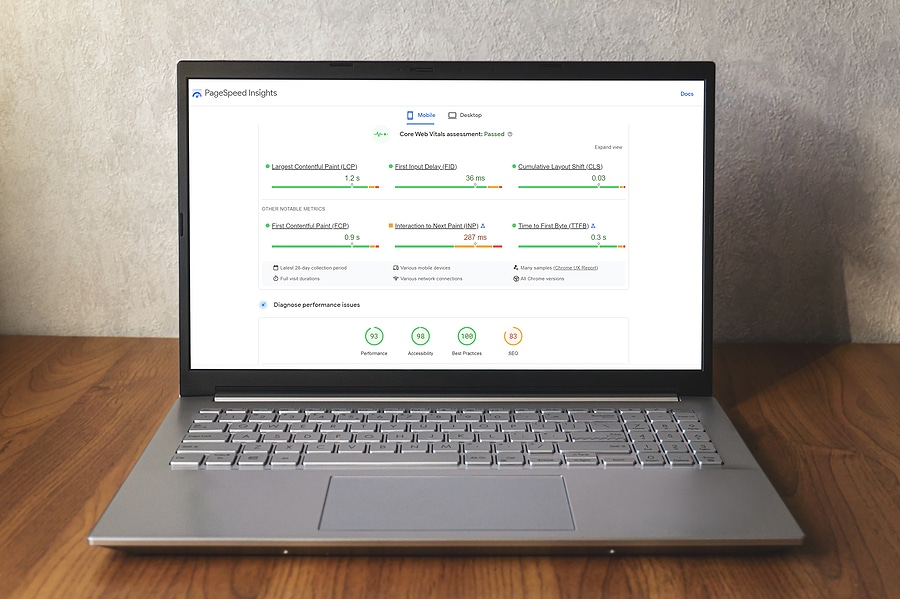
So, your webpage failed Core Web Vitals – now what?
By Socius Staff
June 20, 2024
If you ran a PageSpeed Insights report on your website and got slapped with a big, red, failing Core Web Vitals score – don’t panic.
A failing grade in a PageSpeed Insights report does not mean that your website is broken and it doesn’t mean that your site isn’t going to rank in search results.
Page speed is a hot button issue in the world of SEO and there is a lot of debate amongst thought-leaders as to how it impacts websites, what business owners should do about site speed issues, and where to focus efforts.
Let’s dig into some of the most common assumptions and misconceptions about page speed and how to address them.
Common Misconceptions & Assumptions About SEO & Page Speed
The Assumption: You’ve failed Core Web Vitals and now your website can’t rank well.
TLDR – Huge brands and well-ranking SMB websites can dominate top SERP positions and still fail Core Web Vitals.
True or False? False
The Reality: A failed CWV score doesn’t mean your website isn’t going to rank well in SERPs, in fact, a website in the first position for a competitive term could easily still fail CWV. For example, Amazon (yes, THE Amazon) ranks in the first position for the term “smart watches” and the ranking URL gets a failing CWV score. Apple, the manufacturer of a very popular smart watch ranks in the 9th position in organic results and they fail CWV, too. In fact, it takes 13 positions to make it to a website that even passes CWVs. Fun fact, the 13th page in results that passes CWVs? Google’s smartwatch page.
What this example shows us, is that site speed alone isn’t a silver bullet. It may certainly play a role in the equation, but it’s not going to automatically help your page outrank another…even if you are the search engine.
The Solution: If your website has recently taken a ranking nose dive, your SEO team should take a look at all aspects of your site including indexation, site errors, site structure, competition, and yes – site speed and page experience. If everything else is in line and the only remaining issue is site speed, then you’ve diagnosed that as the biggest improvement opportunity. However, if lost rankings is the symptom – the base of your issue is probably rooted elsewhere.
The Assumption: If you fix every error flagged in a PageSpeed Insights report, your website will outrank your competition.
TLDR – Fixing every single issue flagged in a PageSpeed Insights report is probably a waste of development time and dollars because it won’t directly improve your site’s rankings.
True or False? False
The Reality: Imagine your frustration if you were to spend countless development hours tweaking website design to get the all clear from a PageSpeed Insights report and when it’s all said and done, your competition is still outranking you for your core search terms. That’s a harsh pill to swallow, but a common reality.
The Solution: Every 6-months, it’s worth evaluating your site’s CWV scores to identify issues that could contribute to incremental improvement. Beyond investing in a brand new website, an agile development environment that allows for continuous theme updates and pruning should put you in a more confident position when it comes to page experience as a whole.
The Assumption: If you fail CWVs, your website is too slow and will have a very poor user experience.
TLDR – A failed Core Web Vitals score does not mean that your site has a poor UX, in fact it could mean the opposite depending on your industry and searchers’ needs.
True or False? False
The Reality: An older website with excess Java Script, massive images and outdated plugins will certainly load slower. In an environment where we’ve grown to expect immediate results, Google has been smart to place value on a website’s speed and overall page experience, however, a website’s page speed has become a bit of a moving target. There are a lot of factors that can impact page speed scores that have nothing to do with a website’s overall health.
Search Engine Journal states, “With the rise in mobile browsing and improved bandwidth, page speed may be less of a differentiator compared to a decade ago when slower connections were more common.”
So, while a site’s homepage may take a millisecond longer to load than what PageSpeed Insights considers to be a passing score – that doesn’t mean that a user will have a negative experience on the site. In fact, certain websites in certain industries need to have features that traditionally skew sites slower. For example, if you are searching online for a new car and you want to “oh” and “awe” over luxury features, you’re going to need large galleries to lust over wood grained steering wheels and buttery leather seats in a myriad of hues. Massive car brands have traditionally nominal page speed scores because of page features such as this, but it does not make for a negative user experience and it certainly isn’t going to deter someone from buying a Mercedes Benz.
Ultimately, you have to think about how site speed vs. Design features play into a website’s industry and experience expectations. Let’s say you are comparing local home remodeling companies
- One company has a fast and simple site, but no glossy before and after photos,
- The second business has a slightly slower site but it features reviews and testimonials, with real-life examples of glamorous kitchen remodels and awe-inspiring bathrooms
Ask yourself, “which experience is more likely to convert a homeowner looking for a high quality remodeler?” Spoiler alert – it’s the second business.
The Solution: Do not let site speed be the most important aspect of your website if it gets in the way of the user’s experience. Think about your ideal customer profile and their ideal experience when they come to your site. If you’re concerned about SERP rankings – think about what is most important when it comes to Google’s ranking algorithm. This can feel like a moving target with constant algorithm updates, but there is one core factor at the heart of Google’s search experience. Spoiler alert, it’s relevance – not site speed.
The Assumption: Google considers page speed to be the most important ranking factor for a website.
TLDR – The #1 ranking factor for a website is relevance to search intent, not page speed.
True or False? False
The Reality: Google has long stated that the #1 ranking factor for a website is relevance. This means that if a website offers helpful, unique content and focus on the search intent of users’ queries, the website will be set up for success.
If site speed was the most important factor, then theoretically a faster, less helpful website would outrank a slower, more relevant site. However, if this were true, it would create a negative search experience for many users – which goes against Google’s primary purpose. Over the years, the company has expressed that page speed is certainly a ranking factor, however in the last year, in line with the helpful content algorithm update, they have clarified their statements to say that Google does directly reward good page experience signals, but they removed “page experience” system as one of their ranking systems.
The Solution: First, look at the terms your business is trying to rank for and evaluate whether the intent of these terms is going to help grow your business and leads. Yes? Great. Now, you need to design a comprehensive SEO and content strategy that will allow you to serve content that will match your audience’s need and search intent. It will take time to build up the helpful content required to rank and rank well, but if done right the success will be sustainable.


